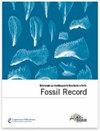下载PDF
{"title":"The late Pleistocene horned crocodile Voay robustus (Grandidier & Vaillant, 1872) from Madagascar in the Museum für Naturkunde Berlin","authors":"Constanze Bickelmann, Nicole Klein","doi":"10.1002/mmng.200800007","DOIUrl":null,"url":null,"abstract":"<p>Crocodylian material from late Pleistocene localities around Antsirabe, Madagascar, stored in the collection of the Museum für Naturkunde, Berlin, was surveyed. Several skeletal elements, including skull bones, vertebrae, ribs, osteoderms, and limb bones from at least three large individuals could be unambiguously assigned to the genus <i>Voay</i> Brochu, 2007. Furthermore, the simultaneous occurrence of <i>Voay robustus</i> Grandidier & Vaillant, 1872 and <i>Crocodylus niloticus</i> Laurenti, 1768 in Madagascar is discussed. <i>Voay robustus</i> and <i>Crocodylus niloticus</i> are systematically separate but similar in stature and size, which would make them direct rivals for ecological resources. Our hypothesis on the extinction of the species <i>Voay</i>, which was endemic to Madagascar, suggests that <i>C. niloticus</i> invaded Madagascar only after <i>V. robustus</i> became extinct. (© 2009 WILEY-VCH Verlag GmbH & Co. KGaA, Weinheim)</p>","PeriodicalId":55147,"journal":{"name":"Fossil Record","volume":"12 1","pages":"13-21"},"PeriodicalIF":2.1000,"publicationDate":"2009-02-20","publicationTypes":"Journal Article","fieldsOfStudy":null,"isOpenAccess":false,"openAccessPdf":"https://sci-hub-pdf.com/10.1002/mmng.200800007","citationCount":"16","resultStr":null,"platform":"Semanticscholar","paperid":null,"PeriodicalName":"Fossil Record","FirstCategoryId":"89","ListUrlMain":"https://onlinelibrary.wiley.com/doi/10.1002/mmng.200800007","RegionNum":4,"RegionCategory":"地球科学","ArticlePicture":[],"TitleCN":null,"AbstractTextCN":null,"PMCID":null,"EPubDate":"","PubModel":"","JCR":"Q3","JCRName":"Earth and Planetary Sciences","Score":null,"Total":0}
引用次数: 16
引用
批量引用
Abstract
Crocodylian material from late Pleistocene localities around Antsirabe, Madagascar, stored in the collection of the Museum für Naturkunde, Berlin, was surveyed. Several skeletal elements, including skull bones, vertebrae, ribs, osteoderms, and limb bones from at least three large individuals could be unambiguously assigned to the genus Voay Brochu, 2007. Furthermore, the simultaneous occurrence of Voay robustus Grandidier & Vaillant, 1872 and Crocodylus niloticus Laurenti, 1768 in Madagascar is discussed. Voay robustus and Crocodylus niloticus are systematically separate but similar in stature and size, which would make them direct rivals for ecological resources. Our hypothesis on the extinction of the species Voay , which was endemic to Madagascar, suggests that C. niloticus invaded Madagascar only after V. robustus became extinct. (© 2009 WILEY-VCH Verlag GmbH & Co. KGaA, Weinheim)
来自马达加斯加的晚更新世角鳄Voay robustus (granddier & Vaillant, 1872),收藏于柏林自然博物馆
研究人员对保存在柏林自然博物馆(Museum r Naturkunde)的马达加斯加安茨拉贝(Antsirabe)附近晚更新世地区的鳄鱼材料进行了调查。来自至少三个大型个体的几种骨骼元素,包括颅骨、椎骨、肋骨、骨皮和肢骨,可以明确地归属于该属。此外,同时发生的Voay robustus granddier &讨论了1872年的Vaillant和1768年在马达加斯加的niloticus Laurenti。粗壮鳄和尼罗鳄在系统上是分开的,但在身高和大小上相似,这将使它们成为生态资源的直接竞争对手。我们对马达加斯加特有的Voay物种灭绝的假设表明,C. niloticus是在V. robustus灭绝之后才入侵马达加斯加的。(©2009 WILEY-VCH Verlag GmbH &KGaA公司,Weinheim)
本文章由计算机程序翻译,如有差异,请以英文原文为准。

 求助内容:
求助内容: 应助结果提醒方式:
应助结果提醒方式:


